University Essay: International and National Corruption Analysis
VerifiedAdded on 2023/05/28
|5
|1323
|438
Essay
AI Summary
This essay delves into the pervasive issue of corruption, examining its manifestations at both international and national levels, with a particular focus on developing nations. The essay explores the underlying reasons for corruption, including historical, cultural, and economic factors, as well as the role of political institutions and governmental policies. It highlights the impact of corruption on various aspects of society, such as undermining the rule of law, democracy, and human rights. The essay provides comparative examples using the Corruption Perceptions Index (CPI) data, contrasting the corruption levels in countries like Japan and Ukraine. It further discusses the role of the executive branches, legal systems, and the need for transparency. The essay also examines the role of developed nations, including the use of tax havens and bank secrecy. It concludes by advocating for stronger anti-corruption frameworks and innovative approaches at both national and international levels, emphasizing the importance of transparency and cooperation.
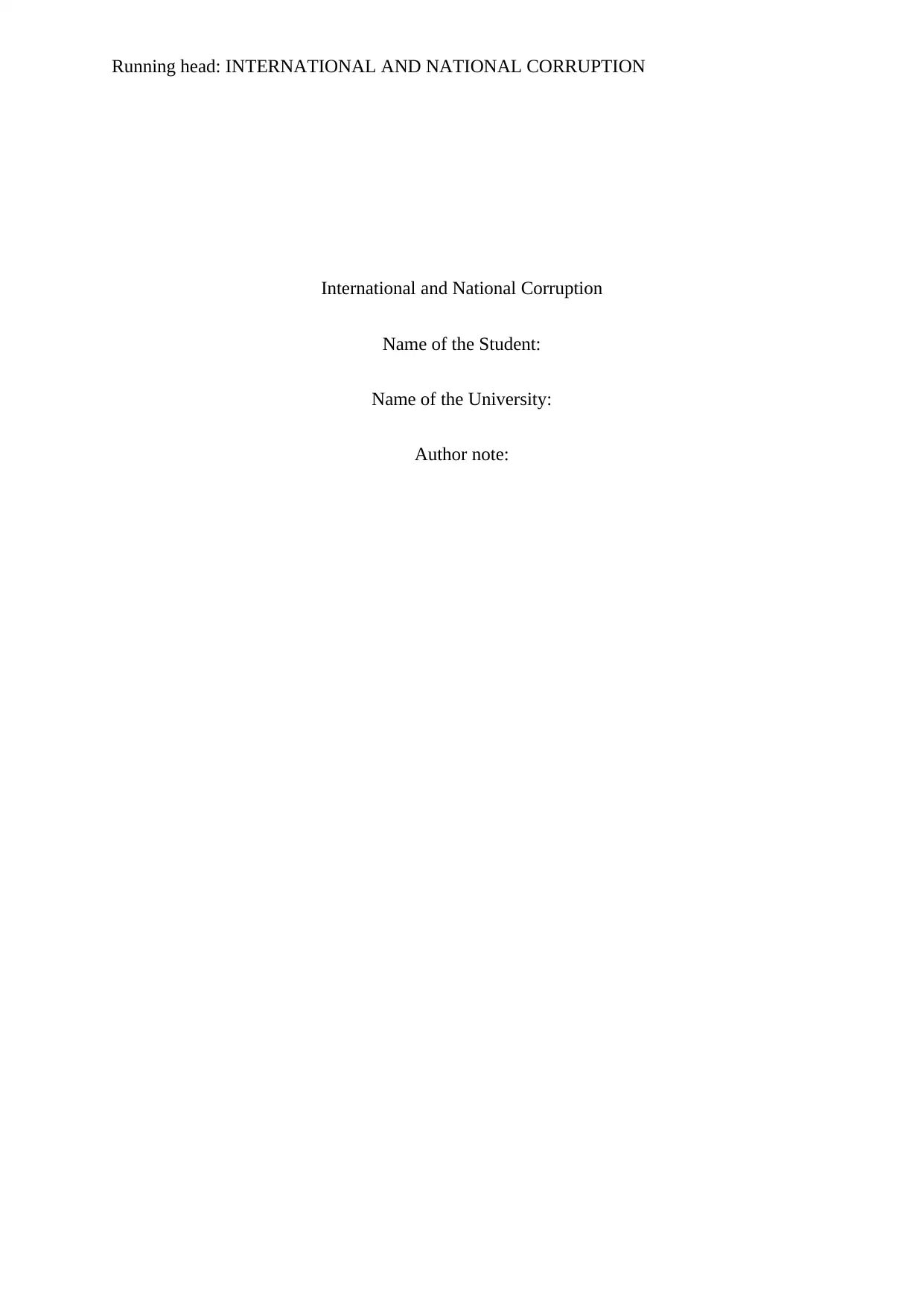
Running head: INTERNATIONAL AND NATIONAL CORRUPTION
International and National Corruption
Name of the Student:
Name of the University:
Author note:
International and National Corruption
Name of the Student:
Name of the University:
Author note:
Paraphrase This Document
Need a fresh take? Get an instant paraphrase of this document with our AI Paraphraser
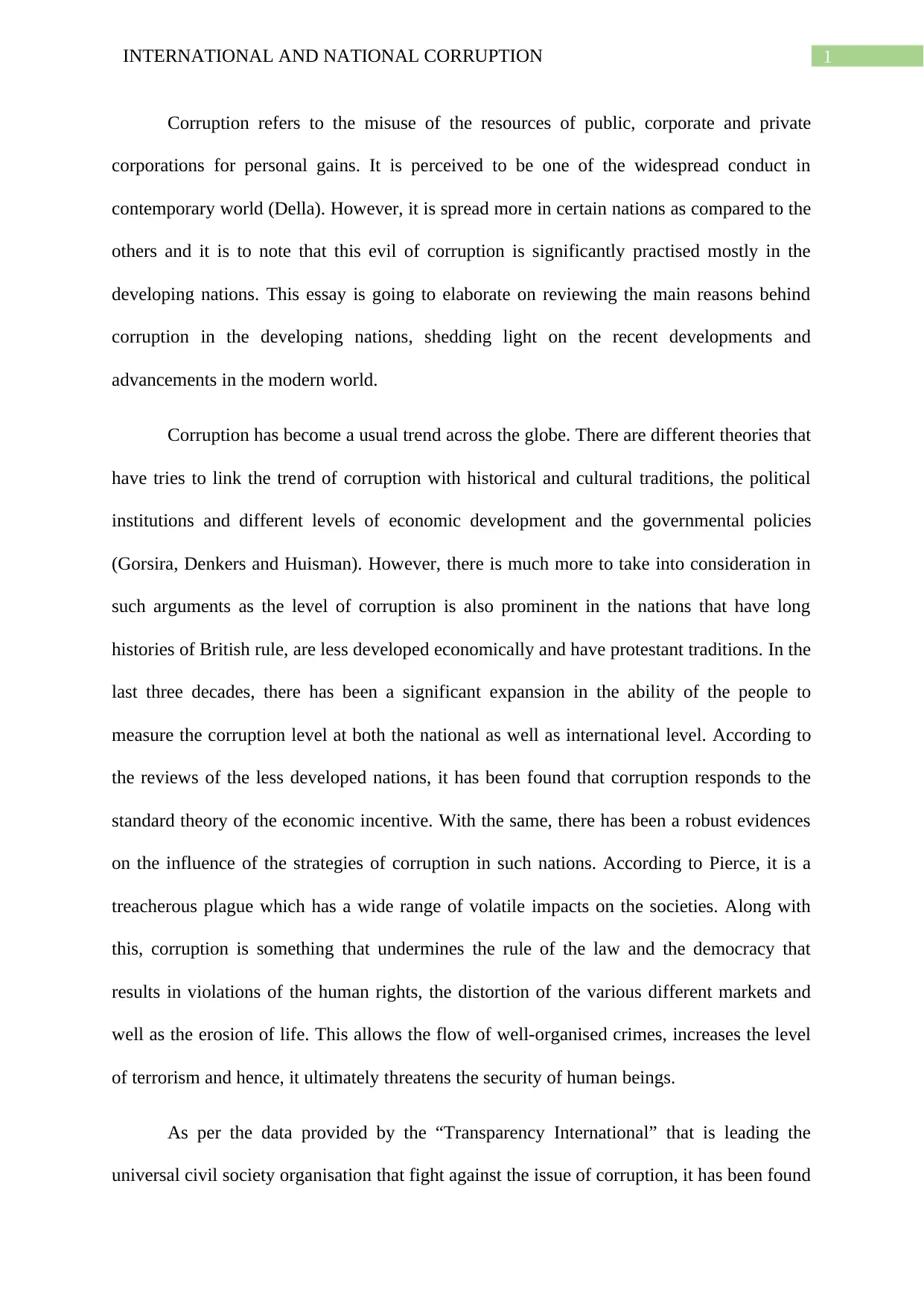
1INTERNATIONAL AND NATIONAL CORRUPTION
Corruption refers to the misuse of the resources of public, corporate and private
corporations for personal gains. It is perceived to be one of the widespread conduct in
contemporary world (Della). However, it is spread more in certain nations as compared to the
others and it is to note that this evil of corruption is significantly practised mostly in the
developing nations. This essay is going to elaborate on reviewing the main reasons behind
corruption in the developing nations, shedding light on the recent developments and
advancements in the modern world.
Corruption has become a usual trend across the globe. There are different theories that
have tries to link the trend of corruption with historical and cultural traditions, the political
institutions and different levels of economic development and the governmental policies
(Gorsira, Denkers and Huisman). However, there is much more to take into consideration in
such arguments as the level of corruption is also prominent in the nations that have long
histories of British rule, are less developed economically and have protestant traditions. In the
last three decades, there has been a significant expansion in the ability of the people to
measure the corruption level at both the national as well as international level. According to
the reviews of the less developed nations, it has been found that corruption responds to the
standard theory of the economic incentive. With the same, there has been a robust evidences
on the influence of the strategies of corruption in such nations. According to Pierce, it is a
treacherous plague which has a wide range of volatile impacts on the societies. Along with
this, corruption is something that undermines the rule of the law and the democracy that
results in violations of the human rights, the distortion of the various different markets and
well as the erosion of life. This allows the flow of well-organised crimes, increases the level
of terrorism and hence, it ultimately threatens the security of human beings.
As per the data provided by the “Transparency International” that is leading the
universal civil society organisation that fight against the issue of corruption, it has been found
Corruption refers to the misuse of the resources of public, corporate and private
corporations for personal gains. It is perceived to be one of the widespread conduct in
contemporary world (Della). However, it is spread more in certain nations as compared to the
others and it is to note that this evil of corruption is significantly practised mostly in the
developing nations. This essay is going to elaborate on reviewing the main reasons behind
corruption in the developing nations, shedding light on the recent developments and
advancements in the modern world.
Corruption has become a usual trend across the globe. There are different theories that
have tries to link the trend of corruption with historical and cultural traditions, the political
institutions and different levels of economic development and the governmental policies
(Gorsira, Denkers and Huisman). However, there is much more to take into consideration in
such arguments as the level of corruption is also prominent in the nations that have long
histories of British rule, are less developed economically and have protestant traditions. In the
last three decades, there has been a significant expansion in the ability of the people to
measure the corruption level at both the national as well as international level. According to
the reviews of the less developed nations, it has been found that corruption responds to the
standard theory of the economic incentive. With the same, there has been a robust evidences
on the influence of the strategies of corruption in such nations. According to Pierce, it is a
treacherous plague which has a wide range of volatile impacts on the societies. Along with
this, corruption is something that undermines the rule of the law and the democracy that
results in violations of the human rights, the distortion of the various different markets and
well as the erosion of life. This allows the flow of well-organised crimes, increases the level
of terrorism and hence, it ultimately threatens the security of human beings.
As per the data provided by the “Transparency International” that is leading the
universal civil society organisation that fight against the issue of corruption, it has been found
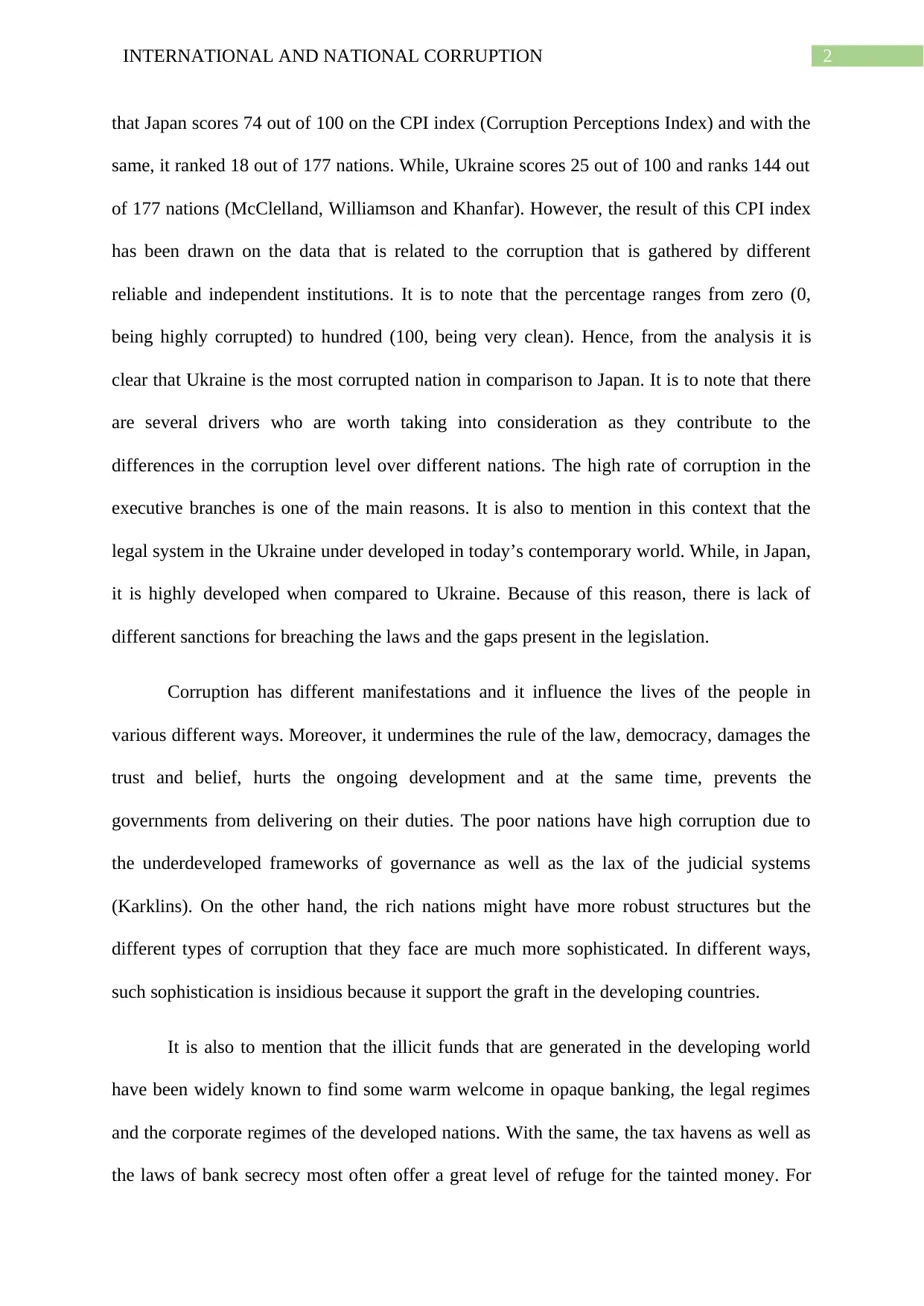
2INTERNATIONAL AND NATIONAL CORRUPTION
that Japan scores 74 out of 100 on the CPI index (Corruption Perceptions Index) and with the
same, it ranked 18 out of 177 nations. While, Ukraine scores 25 out of 100 and ranks 144 out
of 177 nations (McClelland, Williamson and Khanfar). However, the result of this CPI index
has been drawn on the data that is related to the corruption that is gathered by different
reliable and independent institutions. It is to note that the percentage ranges from zero (0,
being highly corrupted) to hundred (100, being very clean). Hence, from the analysis it is
clear that Ukraine is the most corrupted nation in comparison to Japan. It is to note that there
are several drivers who are worth taking into consideration as they contribute to the
differences in the corruption level over different nations. The high rate of corruption in the
executive branches is one of the main reasons. It is also to mention in this context that the
legal system in the Ukraine under developed in today’s contemporary world. While, in Japan,
it is highly developed when compared to Ukraine. Because of this reason, there is lack of
different sanctions for breaching the laws and the gaps present in the legislation.
Corruption has different manifestations and it influence the lives of the people in
various different ways. Moreover, it undermines the rule of the law, democracy, damages the
trust and belief, hurts the ongoing development and at the same time, prevents the
governments from delivering on their duties. The poor nations have high corruption due to
the underdeveloped frameworks of governance as well as the lax of the judicial systems
(Karklins). On the other hand, the rich nations might have more robust structures but the
different types of corruption that they face are much more sophisticated. In different ways,
such sophistication is insidious because it support the graft in the developing countries.
It is also to mention that the illicit funds that are generated in the developing world
have been widely known to find some warm welcome in opaque banking, the legal regimes
and the corporate regimes of the developed nations. With the same, the tax havens as well as
the laws of bank secrecy most often offer a great level of refuge for the tainted money. For
that Japan scores 74 out of 100 on the CPI index (Corruption Perceptions Index) and with the
same, it ranked 18 out of 177 nations. While, Ukraine scores 25 out of 100 and ranks 144 out
of 177 nations (McClelland, Williamson and Khanfar). However, the result of this CPI index
has been drawn on the data that is related to the corruption that is gathered by different
reliable and independent institutions. It is to note that the percentage ranges from zero (0,
being highly corrupted) to hundred (100, being very clean). Hence, from the analysis it is
clear that Ukraine is the most corrupted nation in comparison to Japan. It is to note that there
are several drivers who are worth taking into consideration as they contribute to the
differences in the corruption level over different nations. The high rate of corruption in the
executive branches is one of the main reasons. It is also to mention in this context that the
legal system in the Ukraine under developed in today’s contemporary world. While, in Japan,
it is highly developed when compared to Ukraine. Because of this reason, there is lack of
different sanctions for breaching the laws and the gaps present in the legislation.
Corruption has different manifestations and it influence the lives of the people in
various different ways. Moreover, it undermines the rule of the law, democracy, damages the
trust and belief, hurts the ongoing development and at the same time, prevents the
governments from delivering on their duties. The poor nations have high corruption due to
the underdeveloped frameworks of governance as well as the lax of the judicial systems
(Karklins). On the other hand, the rich nations might have more robust structures but the
different types of corruption that they face are much more sophisticated. In different ways,
such sophistication is insidious because it support the graft in the developing countries.
It is also to mention that the illicit funds that are generated in the developing world
have been widely known to find some warm welcome in opaque banking, the legal regimes
and the corporate regimes of the developed nations. With the same, the tax havens as well as
the laws of bank secrecy most often offer a great level of refuge for the tainted money. For
⊘ This is a preview!⊘
Do you want full access?
Subscribe today to unlock all pages.

Trusted by 1+ million students worldwide
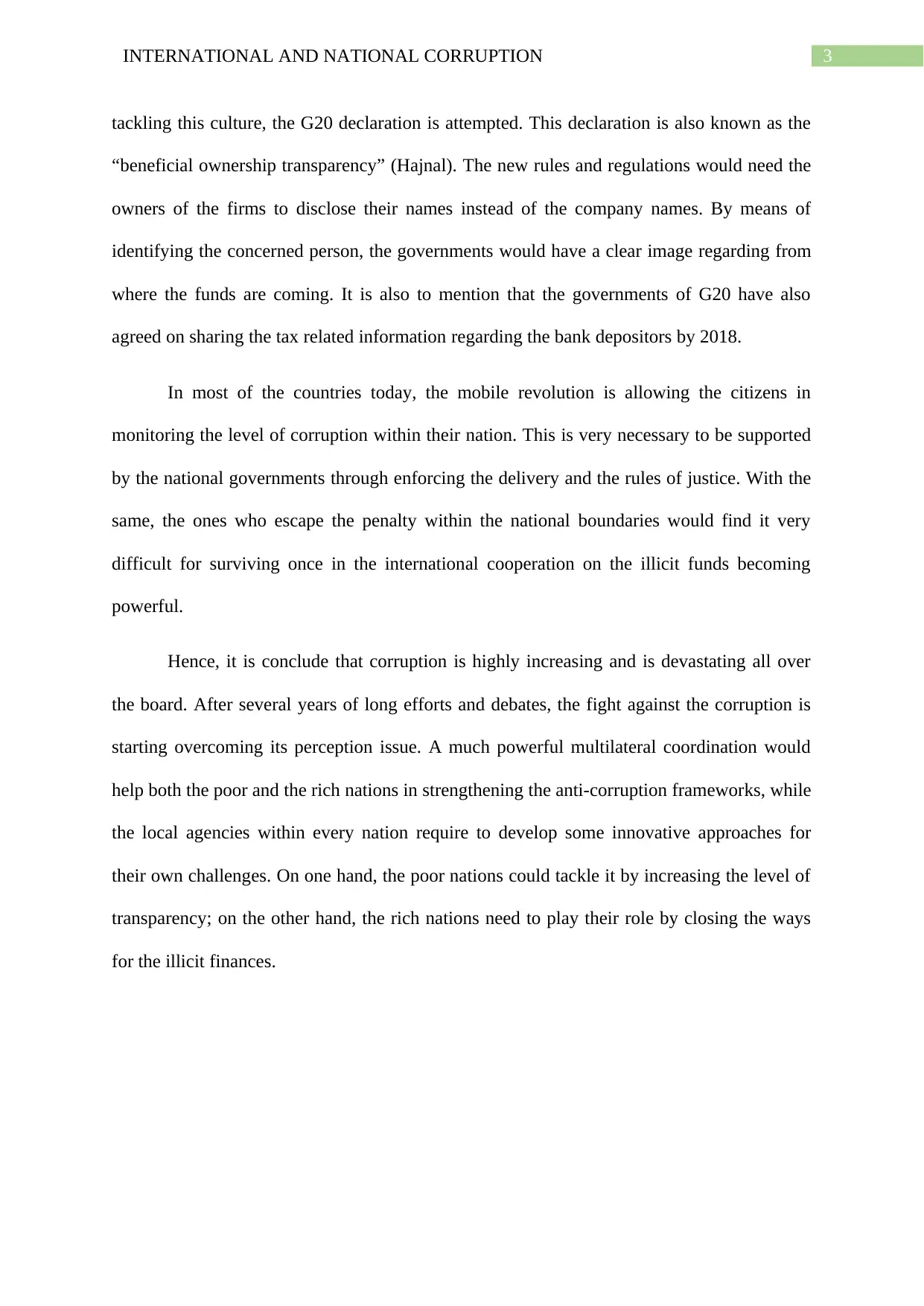
3INTERNATIONAL AND NATIONAL CORRUPTION
tackling this culture, the G20 declaration is attempted. This declaration is also known as the
“beneficial ownership transparency” (Hajnal). The new rules and regulations would need the
owners of the firms to disclose their names instead of the company names. By means of
identifying the concerned person, the governments would have a clear image regarding from
where the funds are coming. It is also to mention that the governments of G20 have also
agreed on sharing the tax related information regarding the bank depositors by 2018.
In most of the countries today, the mobile revolution is allowing the citizens in
monitoring the level of corruption within their nation. This is very necessary to be supported
by the national governments through enforcing the delivery and the rules of justice. With the
same, the ones who escape the penalty within the national boundaries would find it very
difficult for surviving once in the international cooperation on the illicit funds becoming
powerful.
Hence, it is conclude that corruption is highly increasing and is devastating all over
the board. After several years of long efforts and debates, the fight against the corruption is
starting overcoming its perception issue. A much powerful multilateral coordination would
help both the poor and the rich nations in strengthening the anti-corruption frameworks, while
the local agencies within every nation require to develop some innovative approaches for
their own challenges. On one hand, the poor nations could tackle it by increasing the level of
transparency; on the other hand, the rich nations need to play their role by closing the ways
for the illicit finances.
tackling this culture, the G20 declaration is attempted. This declaration is also known as the
“beneficial ownership transparency” (Hajnal). The new rules and regulations would need the
owners of the firms to disclose their names instead of the company names. By means of
identifying the concerned person, the governments would have a clear image regarding from
where the funds are coming. It is also to mention that the governments of G20 have also
agreed on sharing the tax related information regarding the bank depositors by 2018.
In most of the countries today, the mobile revolution is allowing the citizens in
monitoring the level of corruption within their nation. This is very necessary to be supported
by the national governments through enforcing the delivery and the rules of justice. With the
same, the ones who escape the penalty within the national boundaries would find it very
difficult for surviving once in the international cooperation on the illicit funds becoming
powerful.
Hence, it is conclude that corruption is highly increasing and is devastating all over
the board. After several years of long efforts and debates, the fight against the corruption is
starting overcoming its perception issue. A much powerful multilateral coordination would
help both the poor and the rich nations in strengthening the anti-corruption frameworks, while
the local agencies within every nation require to develop some innovative approaches for
their own challenges. On one hand, the poor nations could tackle it by increasing the level of
transparency; on the other hand, the rich nations need to play their role by closing the ways
for the illicit finances.
Paraphrase This Document
Need a fresh take? Get an instant paraphrase of this document with our AI Paraphraser
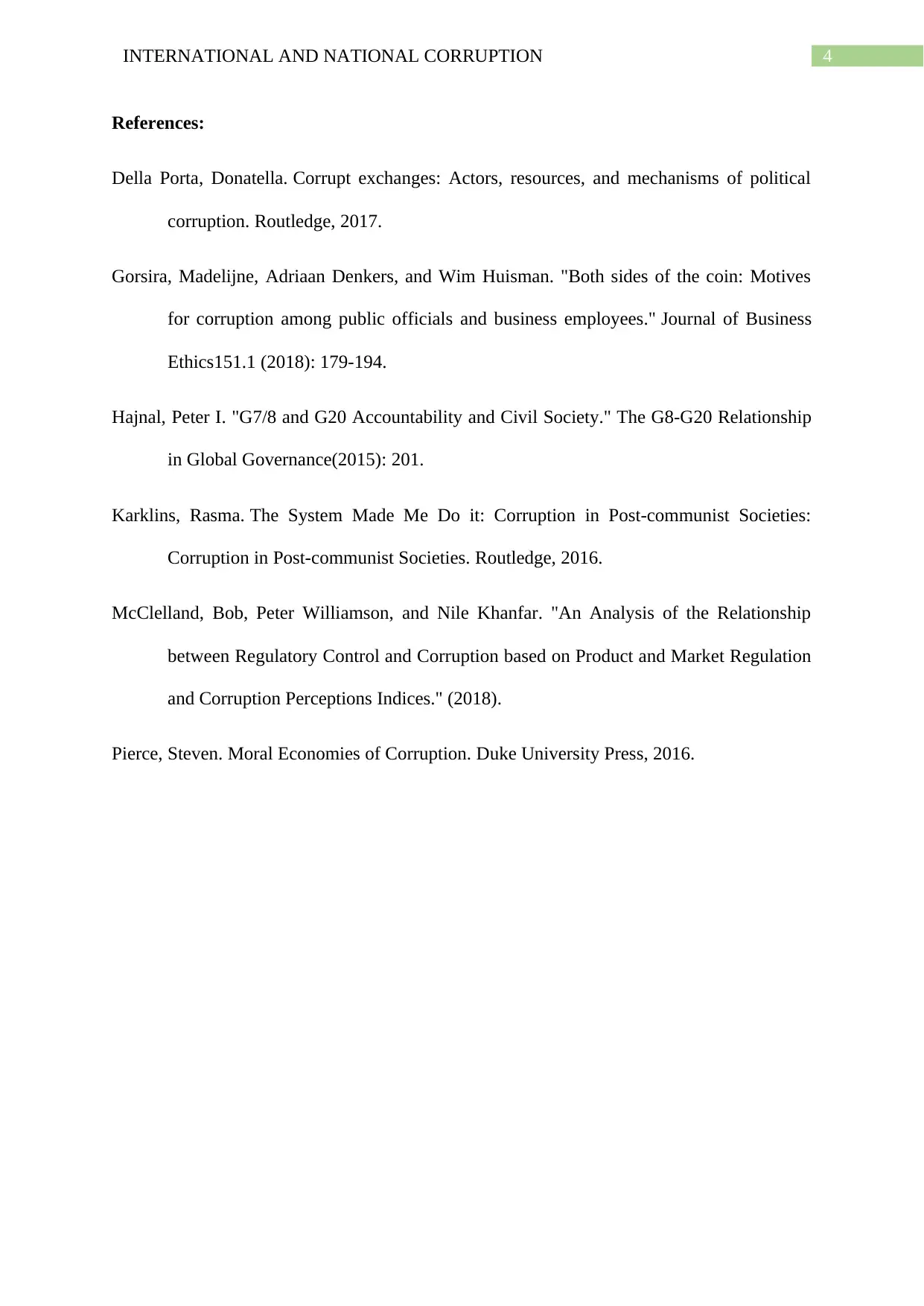
4INTERNATIONAL AND NATIONAL CORRUPTION
References:
Della Porta, Donatella. Corrupt exchanges: Actors, resources, and mechanisms of political
corruption. Routledge, 2017.
Gorsira, Madelijne, Adriaan Denkers, and Wim Huisman. "Both sides of the coin: Motives
for corruption among public officials and business employees." Journal of Business
Ethics151.1 (2018): 179-194.
Hajnal, Peter I. "G7/8 and G20 Accountability and Civil Society." The G8-G20 Relationship
in Global Governance(2015): 201.
Karklins, Rasma. The System Made Me Do it: Corruption in Post-communist Societies:
Corruption in Post-communist Societies. Routledge, 2016.
McClelland, Bob, Peter Williamson, and Nile Khanfar. "An Analysis of the Relationship
between Regulatory Control and Corruption based on Product and Market Regulation
and Corruption Perceptions Indices." (2018).
Pierce, Steven. Moral Economies of Corruption. Duke University Press, 2016.
References:
Della Porta, Donatella. Corrupt exchanges: Actors, resources, and mechanisms of political
corruption. Routledge, 2017.
Gorsira, Madelijne, Adriaan Denkers, and Wim Huisman. "Both sides of the coin: Motives
for corruption among public officials and business employees." Journal of Business
Ethics151.1 (2018): 179-194.
Hajnal, Peter I. "G7/8 and G20 Accountability and Civil Society." The G8-G20 Relationship
in Global Governance(2015): 201.
Karklins, Rasma. The System Made Me Do it: Corruption in Post-communist Societies:
Corruption in Post-communist Societies. Routledge, 2016.
McClelland, Bob, Peter Williamson, and Nile Khanfar. "An Analysis of the Relationship
between Regulatory Control and Corruption based on Product and Market Regulation
and Corruption Perceptions Indices." (2018).
Pierce, Steven. Moral Economies of Corruption. Duke University Press, 2016.
1 out of 5
Related Documents
Your All-in-One AI-Powered Toolkit for Academic Success.
+13062052269
info@desklib.com
Available 24*7 on WhatsApp / Email
![[object Object]](/_next/static/media/star-bottom.7253800d.svg)
Unlock your academic potential
Copyright © 2020–2025 A2Z Services. All Rights Reserved. Developed and managed by ZUCOL.





